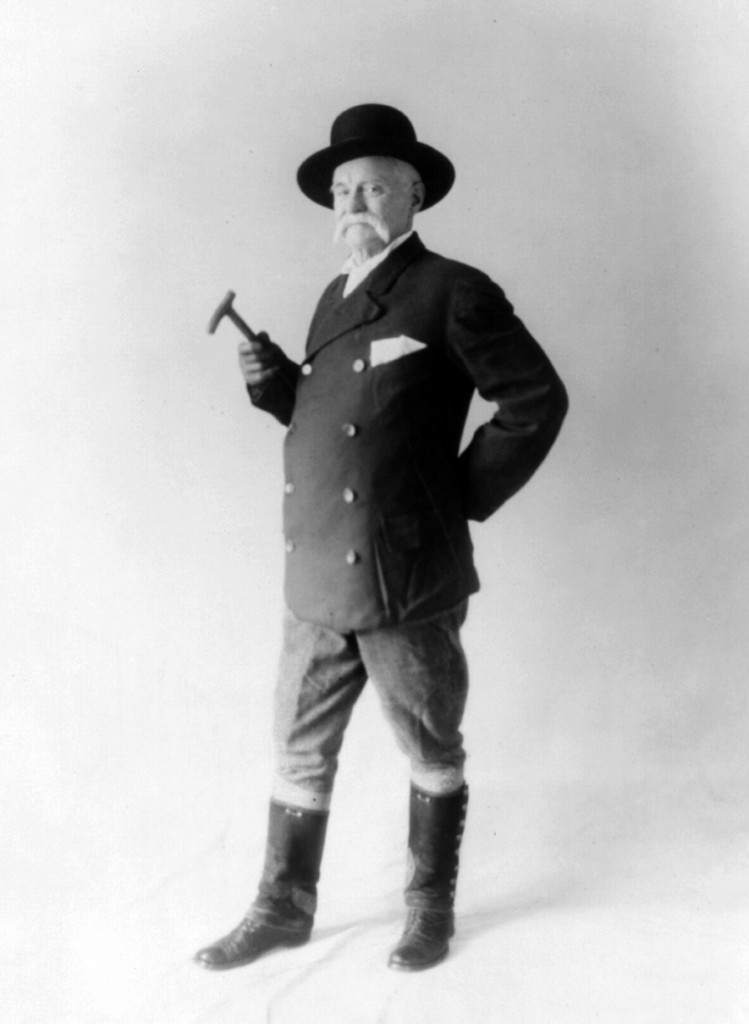Though his child has long vanished from the sporting scene, Edward Payson Weston was known during his lifetime as the “Father of Modern Pedestrianism,” a pastime that rewarded those who could hoof great distances with surprising speed. I’ve blogged about the world-class walker before, when Brian Phillips of Grantland wrote a sparkling piece about the recent Weston biography, A Man in a Hurry. In this classic photograph, the legendary athlete, profiled at 70 years old, was far removed from his glory days of the 1860s-70s, but perhaps because of good health brought about from his peripatetic exploits, he was still twenty years from his death. Of course, it must be noted that his demise may have been hastened by an accident in 1927 in which he was struck by a NYC taxi, as the roads, which had become the domain of cars, had little room for a remnant of the 1800s who was so accursed by their encroachment. Weston could see the future and didn’t like it, though he was helpless, as we all are, to stop it.
In the same year that this image was taken, the native Rhode Islander wrote an article about one of his cross-country walks, a planned 100-day excursion from New York to San Francisco, for the July 16, 1909 New York Times. The article:
“San Francisco, Cal.–Having completed my walk from New York City to San Francisco last night, and enjoyed a restful sleep. I walked to the Post Office Building here this morning and delivered to Postmaster Fiske of San Francisco a letter which I carried in my walk from Postmaster Morgan of New York City. I received a cordial greeting from Postmaster Fisk and his subordinates.
A pleasant incident of my arrival at Oakland last night was the hearty welcome and congratulations extended to me by officials and employees of the Southern Pacific Railroad Company. This company did so much for me that I fail to find words to express my appreciation.
Regarding my feelings and condition, I would say that I feel like uttering bitter words, but do not feel inclined to make excuses.
I have received hundreds of letters and telegrams congratulating me on my wonderful achievement, and each one makes me wish I deserved it. Full of vigor and strength, I am disappointed that the elements were against me, and I frankly acknowledge that had it not been for the unbounded kindness of the officers and employees of the Southern Pacific Railroad Company, I should not have dared to come further than Ogden, Utah. I practically had the right of way on the railroad, and every engineer tooted the whistle on his engine as it passed me.
I contend I walked a distance of upward of 4,000 miles in 104 days and 5 hours, and while it exceeds the distance between New York and San Francisco nearly 700 miles, and far excels any previous record, yet technically it is a failure, and I do not feel inclined to close my public career with a failure.
The expenses of this walk were upwards of $2,500. Some dozen prominent cities in the East have made offers to arrange for testimonial lectures on my return, not only to help liquidate my financial loss, but to show that my object lesson in the journey, in striving to elevate in popular esteem the exercise of walking, is appreciated.
If in the next two weeks I shall receive assurances from a sufficient number of cities and towns between Omaha and New York that they will arrange for lectures and send such word to me in care of the Southern Pacific Railroad Company, San Francisco, then I will try to prove myself worthy of their confidence and esteem by showing how easy it is for any one to walk from San Francisco to New York by direct route within 100 secular days.
There are three very dear friends who oppose this extra walk, but when I convince them that it is my only salvation, and that it would still keep me young and healthy, I know they will fall in with my plans.
Meanwhile the only trouble I have is an awful appetite.”


